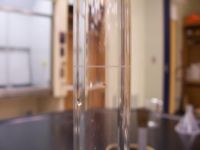Chemical glassware: Difference between revisions
imported>Paul Derry |
imported>Paul Derry No edit summary |
||
| Line 4: | Line 4: | ||
Most laboratory glassware is constructed of heat and chemical resistant Pyrex glass so that it can be used for a variety of different purposes and not pose a serious threat to contaminating the reagents held inside. Some of the glassware seen in a chemistry lab also appear in most other laboratory settings. | Most laboratory glassware is constructed of heat and chemical resistant Pyrex glass so that it can be used for a variety of different purposes and not pose a serious threat to contaminating the reagents held inside. Some of the glassware seen in a chemistry lab also appear in most other laboratory settings. | ||
== Volumetric Flask == | == Volumetric Flask == | ||
[[Image:Volumetric100050025.JPG|thumb|1000mL, 500mL, 25mL Volumetric Flasks| | [[Image:Volumetric100050025.JPG|thumb|1000mL, 500mL, 25mL Volumetric Flasks|200px]] | ||
The '''Volumetric Flask''' is used to dilute a very specific volume of a solution. Each flask is calibrated to hold a certain volume and only that certain volume. Once the reagents in the solution have been added, the flask is then filled to the calibration line, a small etching around the neck of the flask that was established when the flask was manufactured, with the solvent and the flask shaken to ensure a homogeneous solution. Due to the specific calibration mark and a general lack of other markings, these flasks are useless in dispensing an arbitrary volume of solution and thus are only used to make solutions. | The '''Volumetric Flask''' is used to dilute a very specific volume of a solution. Each flask is calibrated to hold a certain volume and only that certain volume. Once the reagents in the solution have been added, the flask is then filled to the calibration line, a small etching around the neck of the flask that was established when the flask was manufactured, [[Image:VolumetricEtch.JPG|thumb|Etch on a 500mL volumetric flask|200px|left]]with the solvent and the flask shaken to ensure a homogeneous solution. Due to the specific calibration mark and a general lack of other markings, these flasks are useless in dispensing an arbitrary volume of solution and thus are only used to make solutions. | ||
[[Category:Chemistry Workgroup]] | [[Category:Chemistry Workgroup]] | ||
[[Category:CZ Live]] | [[Category:CZ Live]] | ||
Revision as of 22:37, 19 February 2007
This article contains a photographic list and brief description of the purpose, benefits, and problems that various pieces of laboratory glassware. The items listed here may be moved to their own separate articles at some point in the future, however, for the time being, this will do.
General
Most laboratory glassware is constructed of heat and chemical resistant Pyrex glass so that it can be used for a variety of different purposes and not pose a serious threat to contaminating the reagents held inside. Some of the glassware seen in a chemistry lab also appear in most other laboratory settings.
Volumetric Flask
The Volumetric Flask is used to dilute a very specific volume of a solution. Each flask is calibrated to hold a certain volume and only that certain volume. Once the reagents in the solution have been added, the flask is then filled to the calibration line, a small etching around the neck of the flask that was established when the flask was manufactured,
with the solvent and the flask shaken to ensure a homogeneous solution. Due to the specific calibration mark and a general lack of other markings, these flasks are useless in dispensing an arbitrary volume of solution and thus are only used to make solutions.

